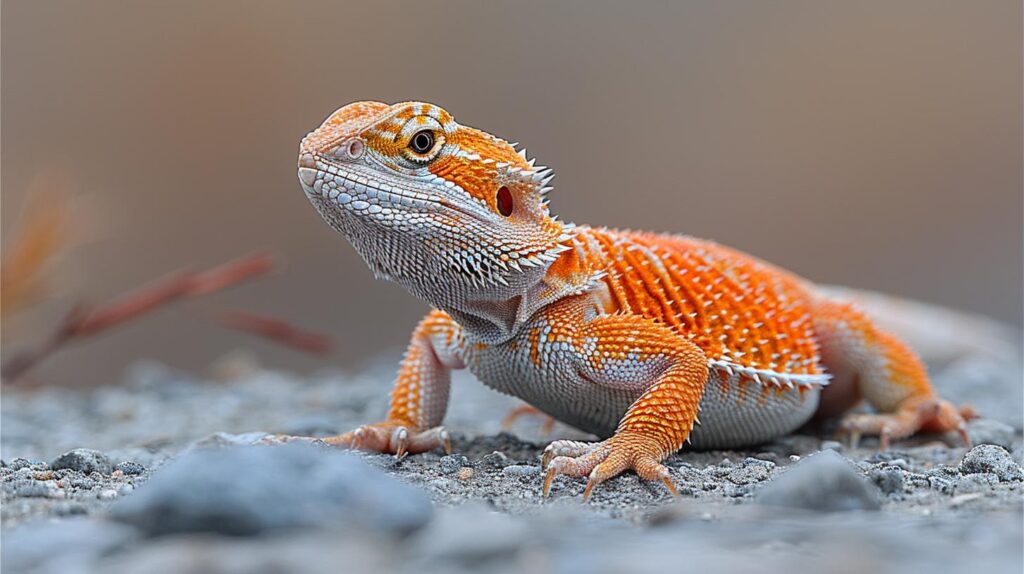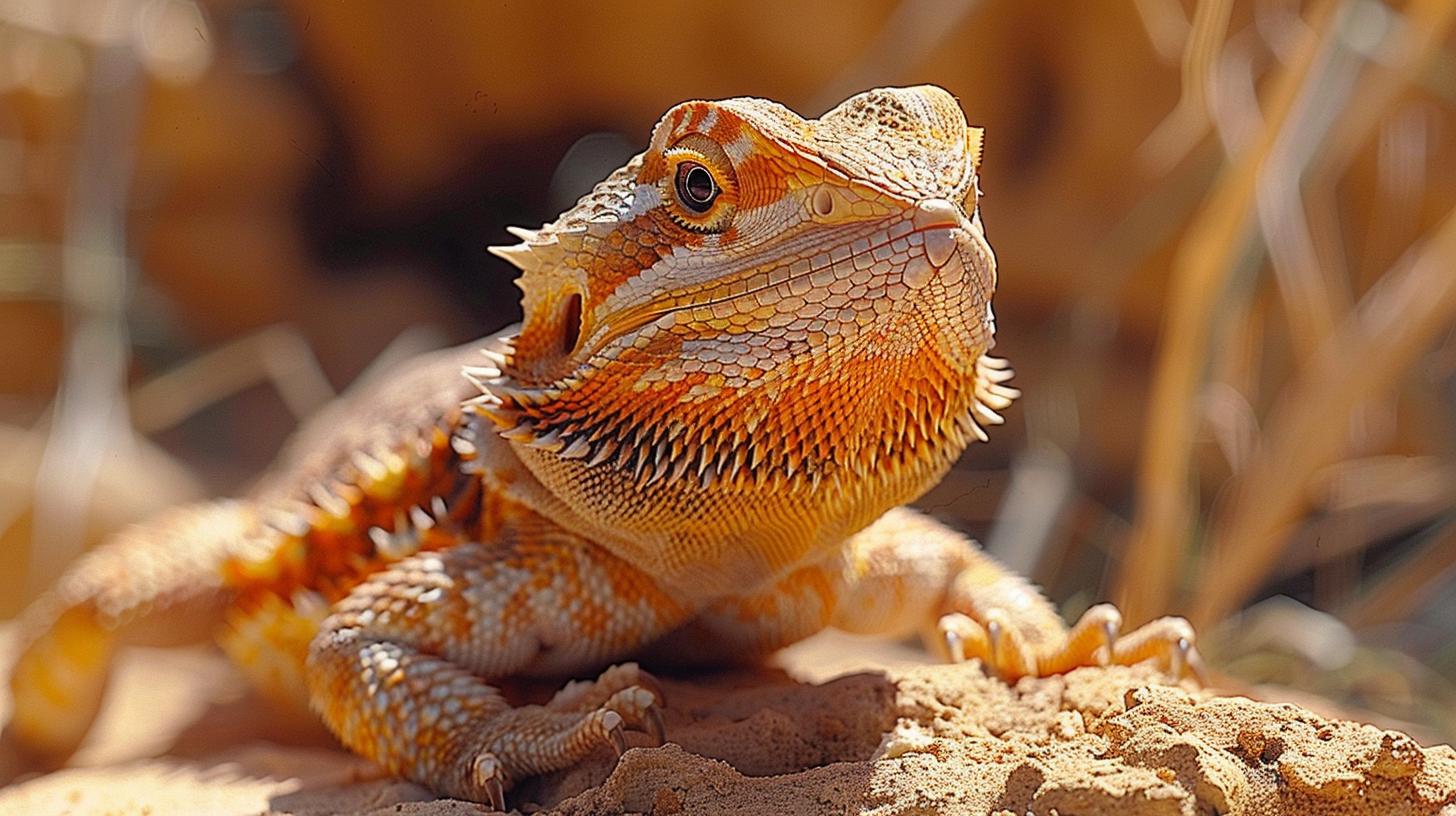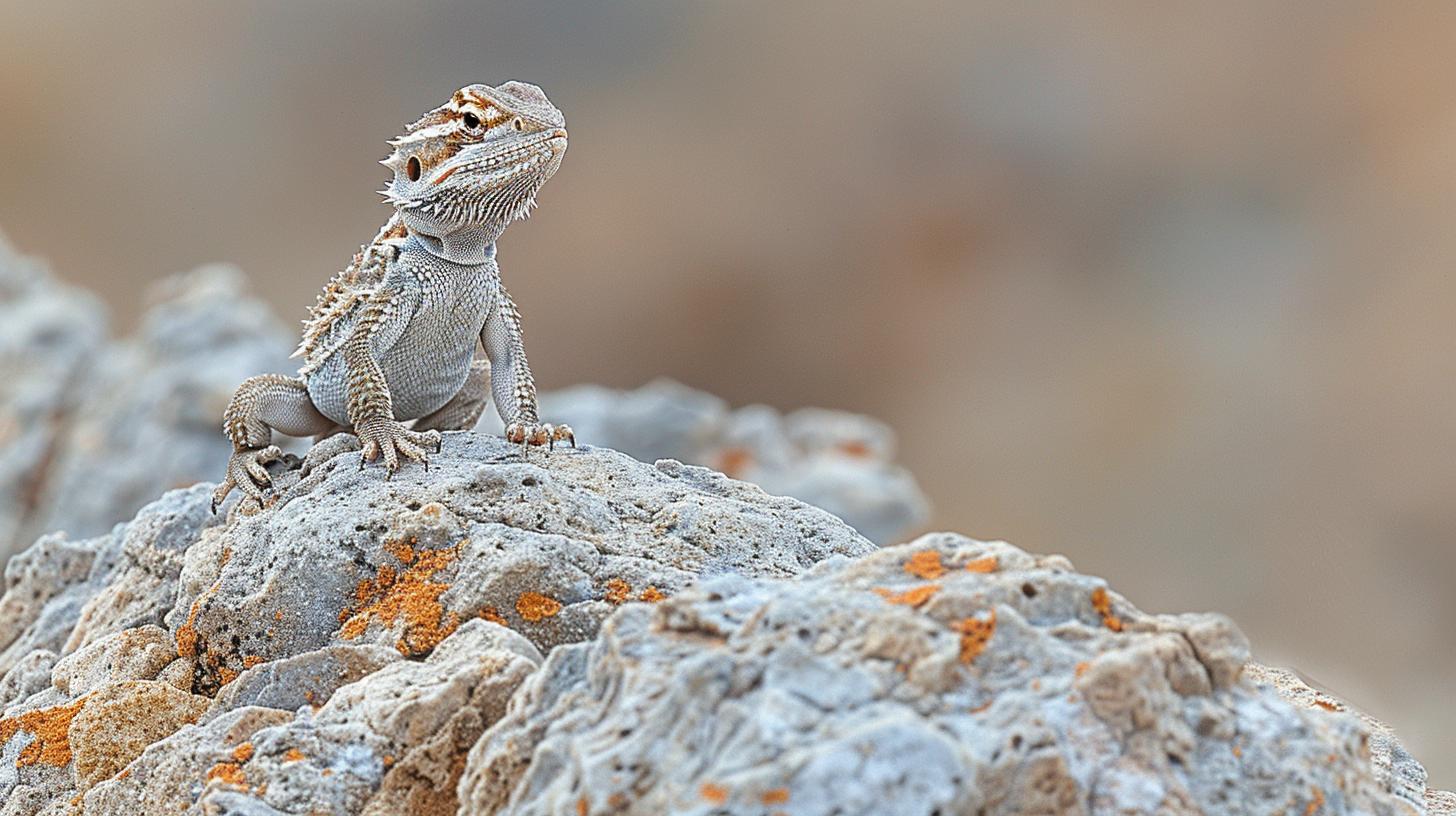What Humidity Level Keeps Bearded Dragons Healthy?

- Understanding Bearded Dragons and Their Habitat Needs
- The Vital Role of Humidity in Bearded Dragon Health
- What Is the Bearded Dragon Perfect Humidity Range?
- Tools and Techniques for Measuring and Adjusting Humidity
- Creating a Humidity-Friendly Environment for Your Bearded Dragon
- Addressing Common Humidity-Related Health Concerns in Bearded Dragons
- Encouraging Best Practices for Long-Term Bearded Dragon Care
- Frequently Asked Questions
Understanding Bearded Dragons and Their Habitat Needs
Finding the bearded dragon perfect humidity level is a cornerstone of creating an ideal environment for these unique reptiles. Known for their distinctive appearance and gentle demeanor, bearded dragons are native to the rugged landscapes of Australia, thriving in areas that range from arid deserts to semi-arid woodlands.
This diversity in habitat underpins the necessity of mimicking similar environmental conditions within captivity to maintain their health and happiness. It's not just about providing a warm basking spot or sufficient space; understanding and replicating the precise humidity levels of their natural habitats plays a critical role in ensuring they thrive under human care.
Humidity plays a vital role in a bearded dragon's overall health, influencing everything from skin condition to respiratory function. In their natural habitat, these reptiles are accustomed to specific humidity levels that help them shed properly and stay hydrated.
However, when held in captivity, achieving and maintaining these optimal levels becomes a task for the pet owner. An environment with humidity too high or too low can lead to a myriad of health issues-skin infections due to excessive moisture or dehydration from air too dry are common problems that can afflict bearded dragons if their habitat is not properly managed.
Identifying the ideal humidity range for bearded dragons is therefore essential. Experts generally agree that maintaining the enclosure's humidity levels between 30% and 40% strikes the perfect balance necessary for their well-being.
Staying within this range helps prevent dehydration on one end and respiratory issues or skin infections on the other-conditions often seen with inappropriate humidity levels. To achieve this balance, a combination of tools for monitoring, such as hygrometers, and techniques for adjusting the enclosure's atmosphere become indispensable parts of responsible bearded dragon care.
Creating an environment that supports suitable humidity levels, requires attention to detail-from choosing the right substrate to ensuring adequate ventilation within the enclosure. These aspects, together with strategic placement of water sources can significantly influence ambient moisture without reaching detrimental extremes. Starting with these foundational elements paves the way towards fostering a healthy living space for bearded dragons where they can exhibit natural behaviors and enjoy life in captivity as much as possible.
The Vital Role of Humidity in Bearded Dragon Health
Humidity plays a pivotal role in the overall health and well-being of bearded dragons, a fact that might not be immediately apparent to new or prospective pet owners. Originating from the arid and semi-arid environments of Australia, these reptiles have evolved to thrive under specific humidity conditions.
As such, when recreating an appropriate habitat for them in captivity, understanding and emulating their natural environmental conditions is essential. However, achieving the perfect balance can often seem daunting due to the myriad factors influencing humidity levels within an enclosure.
High levels of humidity can foster the growth of mold and fungi, potentially triggering respiratory issues or skin infections in bearded dragons. Conversely, an environment that's too dry may lead to dehydration or shedding problems. These potential health risks underscore why maintaining appropriate humidity levels isn't just beneficial; it's crucial for your bearded dragon's health. This balancing act requires not only keen attention but also a clear understanding of what constitutes optimal conditions for these reptiles.
Identifying the Right Humidity Range
To ensure a thriving environment for bearded dragons, identifying the bearded dragon perfect humidity range is critical. Generally speaking, this ideal range lies between 30% to 40%, closely mimicking their native Australian desert habitat. Maintaining humidity within these parameters helps prevent dehydration on one end of the spectrum and respiratory infections on the other-both common issues that arise from incorrect humidity levels. Adhering strictly to this guideline promotes healthy skin shedding cycles and supports overall physiological wellbeing.
Health Implications Outside Ideal Humidity Levels
Straying outside the ideal humidity range can have immediate and long-term health implications for bearded dragons. Conditions that are too humid elevate the risk of fungal and bacterial growth within the enclosure, leading to potential skin infections or more severe respiratory problems that could necessitate veterinary intervention.
On the flip side, exceedingly low humidity levels threaten a bearded dragon's hydration status-a fundamental component of their health given their propensity for infrequent drinking. Both scenarios underscore how deviation from recommended humidity settings impacts not only immediate comfort but also overarching health.
Through careful monitoring and management of enclosure conditions, achieving balanced humidity levels becomes less an exercise in futility and more a manageable aspect of routine care, contributing significantly to cultivating a healthy living space for your bearded dragon pet.
What Is the Bearded Dragon Perfect Humidity Range?
Discovering the *bearded dragon perfect humidity* range is pivotal for aspiring and seasoned bearded dragon owners alike. The arid and semi-arid regions from where these captivating creatures hail dictate a specific set of environmental conditions for optimum health in captivity. Striking the right balance in humidity is not just about preventing discomfort but ensuring a thriving ecosystem for your pet.
The ideal humidity level for bearded dragons hovers between 30% to 40%. This range mimics their natural habitat, promoting good health while minimizing the risk of dehydration or respiratory issues that can arise from less than optimal conditions.

Maintaining this narrow window of *bearded dragon perfect humidity* requires a blend of vigilance and technical assistance. Tools such as digital hygrometers play an indispensable role, offering accurate readings that can guide adjustments in real time. It's essential to integrate monitoring into your daily routine, ensuring that fluctuations - either towards dryness or excessive moisture - are addressed promptly. Variations outside the desired range, even if slight, necessitate immediate correction to prevent latent health complications.
Creating an environment conducive to maintaining this delicate balance involves several actionable items:
- Choosing the Right Substrate: Select materials that do not retain excessive moisture, such as newspaper or reptile carpet. Avoid substrates like sand or bark that can alter humidity levels unpredictably.
- Ventilation: Ensure your enclosure has adequate ventilation to facilitate air circulation without letting humidity escape too rapidly.
- Water Practices: Placement of water bowls can influence local humidity levels within the enclosure. Positioning them away from heat sources helps in controlling evaporation rates.
This section transitions seamlessly into practical advice on tailoring your setup to meet these humidification challenges. By employing a combination of accurate measurement tools and judicious environmental adjustments, sustaining the *bearded dragon perfect humidity* becomes not only feasible but also a cornerstone of responsible pet care. In turn, this attention to detail paves the way for addressing specific health concerns directly tied to inappropriate humidity levels, underscoring its significance in holistic bearded dragon wellness strategies.
Tools and Techniques for Measuring and Adjusting Humidity
Maintaining the right level of humidity within a bearded dragon's habitat is not just beneficial; it's imperative for their health and well-being. In the wild, these reptiles thrive in environments that have specific humidity ranges, which can vary significantly from the conditions found in many homes.
Consequently, pet owners need to take proactive steps to measure and regulate humidity to mirror the *natural habitat* of bearded dragons as closely as possible. Understanding and implementing the correct tools and techniques for this purpose forms a cornerstone of responsible bearded dragon care.
To accurately monitor humidity levels, a digital hygrometer is essential. This device provides precise readings, allowing owners to make informed decisions about adjustments needed to maintain the bearded dragon perfect humidity range.
Without such detailed monitoring, it's challenging to prevent the habitat from becoming too moist or too dry-conditions that can lead to serious health issues for the bearded dragon. It's vital that these instruments are checked regularly for accuracy because even small deviations outside the ideal range can impact a bearded dragon's health.
Once you've established a method for accurately measuring humidity levels, adjusting them becomes your next focus area. Techniques such as misting the enclosure lightly can increase humidity if levels drop too low. Conversely, improving ventilation can help reduce excess moisture in the air if readings are consistently too high.
Adding or removing water bowls and adjusting room humidifiers or dehumidifiers nearby also provide effective ways to fine-tune environmental conditions within an enclosure. Each of these methods offers a practical approach to maintaining optimal conditions, safeguarding your pet's health through diligent habitat management.
Creating a Humidity-Friendly Environment for Your Bearded Dragon
Creating a habitat that mirrors the natural environment of bearded dragons is not just about aesthetics; it's essential for their health and longevity. The ambiance within their enclosure plays a pivotal role, particularly the humidity levels, which can significantly impact their well-being. Ensuring the enclosure maintains the bearded dragon perfect humidity is crucial. This means paying special attention to various elements within their habitat to create a space that fosters health and happiness.
Choosing the Right Substrate
The foundation of creating an optimal environment starts with selecting the appropriate substrate. Certain substrates can retain moisture better than others, contributing to maintaining the ideal humidity levels.
For bearded dragons, it's important to avoid substrates that are overly moist or tend to mold easily as this can lead to respiratory infections or skin issues. Instead, opting for dry substrates such as newspaper, ceramic tiles, or specially formulated reptile carpeting can help keep the habitat's humidity in check while being easy to clean and replace.
Ventilation: A Key Component
Another critical aspect in regulating humidity is proper ventilation. Enclosures that are too tightly sealed may trap moisture excessively, creating a humid environment prone to bacterial growth and respiratory problems.
On the other hand, too much ventilation might cause the air inside to become too dry, leading away from achieving the bearded dragon perfect humidity By installing screen tops or providing adequate ventilation slots on the enclosure sides, you ensure a steady circulation of air that helps maintain a balanced level of humidity conducive to your bearded dragon's health.
Water Sources and Their Placement
While water is essential for life, its placement within a bearded dragon's enclosure can drastically affect ambient humidity levels. Large water bowls or frequent misting may raise humidity beyond desirable levels, especially in smaller enclosures where moisture cannot disperse evenly.
Conversely, providing fresh water through shallow dishes and controlling misting routines ensures your pet stays hydrated without inadvertently spiking the enclosure's humidity. This practice aids in keeping conditions stable, avoiding fluctuations that could stress or harm your reptilian companion.

In summary, crafting a living space for your bearded dragon that promotes perfect humidity involves careful consideration of substrate choice, adequate ventilation, and thoughtful water placement. These elements work harmoniously to replicate conditions close to their natural habitat while preventing health issues linked with incorrect humidity levels.
Maintaining the bearded dragon perfect humidity level within their habitat is not just about ensuring comfort but also about preventing a variety of health issues that can arise from improper humidity levels. When the humidity in a bearded dragon's enclosure is too low, it can lead to dehydration, which is detrimental to their health. Dehydration in bearded dragons can manifest through sunken eyes, lethargy, and a loss of appetite.
Conversely, excessive humidity can create an environment conducive to the growth of bacteria and fungi, potentially leading to skin infections and respiratory problems. It's essential to strike a delicate balance to foster an environment that mirrors their natural habitat.
| Humidity Issue | Potential Health Concern |
|---|---|
| Low Humidity | Dehydration, Shedding Problems |
| High Humidity | Skin Infections, Respiratory Issues |
Creating an environment that maintains the ideal humidity range for bearded dragons is crucial in mitigating these risks. Low humidity environments may require regular misting or adding water bowls to increase moisture levels. For habitats where moisture levels are excessively high, improving ventilation or using dehumidifiers can help reduce humidity. Monitoring these levels closely with reliable hygrometers will ensure that any adjustments made are effective and that the habitat consistently remains within the optimal range for bearded dragon perfect humidity.
Preventing these common health concerns requires proactive measures and a commitment to regular habitat maintenance. Implementing daily checks on hydration sources, substrate conditions, and overall enclosure ambiance will play a significant role in preempting potential issues.
Additionally, being mindful of seasonal changes that could affect indoor humidity levels will further safeguard against unexpected shifts that could compromise your bearded dragon's well-being. With diligent care and attention to maintaining appropriate environmental conditions, owners can considerably reduce the likelihood of humidity-related health issues in their beloved pets.
Encouraging Best Practices for Long-Term Bearded Dragon Care
In wrapping up our comprehensive exploration on maintaining the perfect humidity for a bearded dragon's health, we've journeyed through understanding their natural habitat needs to practical tips for creating an ideal living environment. Achieving and sustaining the right humidity level - that golden range establishing a bearded dragon perfect humidity - is not merely beneficial, but a necessity for their well-being.
This dedication mimics the arid conditions they thrive in naturally, preventing common but severe health issues ranging from dehydration to respiratory infections.
As caretakers of these fascinating creatures, it becomes our responsibility to adhere closely to these guidelines, leveraging modern tools like hygrometers and adjusting our enclosures with techniques we've discussed. Regular monitoring and adjustments ensure that your scaly friend benefits from an environment that's as close to its natural habitat as possible.
Balancing humidity within the suggested parameters plays a pivotal role in avoiding skin and respiratory conditions, ensuring your bearded dragon leads a healthy, content life under your care.
We hope this guide empowers you with the knowledge needed to create the safest, most comfortable home for your bearded dragon. This journey doesn't end here; continue enriching your understanding and skills by navigating through additional resources available on our website.
Your commitment shines through the love and effort dedicated toward optimizing your pet's living conditions, highlighting an admirable quest towards providing exceptional care. For more insights on nurturing various aspects of your bearded dragon's life or discovering other facets of pet care, dive into our treasure of articles designed with both novice and seasoned pet owners in mind-your next step towards becoming an even better guardian awaits you here.
Frequently Asked Questions
Is 70% Humidity Too High for a Bearded Dragon?
Yes, 70% humidity is too high for a bearded dragon. These reptiles thrive in environments with lower humidity levels, typically between 20-40%. High humidity can lead to respiratory infections and other health issues.
What Is the Best Humidity Level for a Bearded Dragon?
The best humidity level for a bearded dragon ranges from 20% to 40%. Maintaining this range helps mimic their natural desert habitat, ensuring they remain healthy and comfortable.
Is 70 Degrees Okay for a Bearded Dragon?
A temperature of 70 degrees Fahrenheit is generally acceptable for a bearded dragon during the night. However, during the day, they require warmer temperatures between 75-85 degrees Fahrenheit in their cool zone and up to 95-110 degrees Fahrenheit in their basking area.
Is 100 Degrees to Hot for Bearded Dragon?
For a bearded dragon, 100 degrees Fahrenheit is not too hot, especially as a basking temperature. They need a basking spot that reaches between 95-110 degrees Fahrenheit to properly digest food and maintain body temperature.
Is 60% Humidity Too High for Bearded Dragon?
While slightly higher than ideal, 60% humidity is not excessively high for a bearded dragon but should be monitored closely. Consistently maintaining humidity levels closer to the preferred range of 20-40% is advisable to prevent potential health issues.
Should I Mist My Bearded Dragon?
Misting your bearded dragon occasionally can help maintain proper hydration, especially if they don't drink often from their water dish or are shedding. However, frequent misting is not necessary and can increase humidity excessively. Instead, provide fresh water daily and monitor environmental conditions carefully.
Leave a Reply
You must be logged in to post a comment.